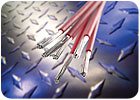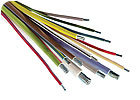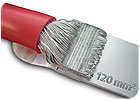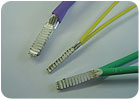
If the wire industry was involved in a boxing match, copper would be touted as the reigning heavyweight champion. The material has dominated the cable and wire market for decades. But, there’s a new lightweight contender in town-aluminum.
Recent price fluctuations have forced some manufacturers to consider alternatives to copper wire, such as copper-clad aluminum, solid-core aluminum and composite wire. Copper prices soared to record levels last month, rising above $4 per pound on several leading metals exchanges-more than a 20 percent increase over 2009 levels.
And, the end may not be in sight for quite a while. Some observers predict that copper may reach $5 a pound by the middle of this year. Unfortunately, it looks like copper supplies will lag demand for at least the next two years. That’s good news for the aluminum industry.
Although it has been getting more attention lately, aluminum wire has been around for many years. Indeed, aluminum has been used successfully since the early 1900s for power delivery applications in the utility grid, due to its lighter weight, flexibility and lower cost.
Aluminum conductors and shield braids have also been used in many low-temperature applications, such as building and communications wire. However, Underwriters Laboratories Inc. does not recommend the use of aluminum wire for applications above 90 C, due to safety and performance concerns that resulted in many home fires during the 1960s.
The marine industry does not allow the use of aluminum conductors, because of corrosion issues with wet environments. Aluminum usage is also very low in the aerospace, appliance and electronics industries, because wire processing is much more difficult and expensive. However, engineers at NASA and the European Space Agency are currently looking into the possibility of using aluminum wire for next-generation space vehicles.
Automotive manufacturing represents the brightest growth potential for aluminum wire and cable. As automakers and suppliers continually look for new way to reduce weight and cut costs, aluminum is a popular candidate for applications that require high current, such as large cables under the hood.

Aluminum Advantages
Engineers at Delphi Automotive LLC have been experimenting with aluminum cable for more than 40 years. During the 1970s, the company mass-produced copper-clad, aluminum-core battery cables that were used in General Motors vehicles. In the 1980s, it produced solid-core aluminum wire for use in rear-lamp wire harnesses.“Today, we’re seeing a lot of growth in the automotive sector,” says Kurt Seifert, crimp technology and contact physics supervisor at Delphi. “As long as cost remains the No. 1 driver in the industry, engineers will be eager to use aluminum wire and cable. Aluminum costs less than one-third as much as copper wire. And, you only need to use about half as much aluminum as copper to make an equivalent conductor.
“Unlike copper, which comes from just a handful of countries, there’s also an abundant supply of aluminum worldwide,” Seifert points out. “And, aluminum is easily recycled.”
Weight reduction is another key advantage of aluminum wire and cable. According to Seifert, it has as much as 48 percent less mass than traditional copper core material. “Approximately 0.5 pound of aluminum can replace 1 pound of copper, allowing about 4 pounds to be trimmed from the weight of a typical vehicle,” he explains.
“Aluminum cable is larger than copper cable, due to the greater cross section of aluminum required to achieve the same conductivity,” adds Seifert. “However, the insulation is also lighter in weight than conventional insulations, further enhancing the weight reduction potential of aluminum.”
As the auto industry ramps up production of hybrid and electric vehicles, there’s a growing need for larger and more complex wiring harnesses. Many OEMs and suppliers are turning to aluminum wire to save weight and reduce cost, especially in big, load-carrying cables.
That’s one reason why several Japanese wire harness suppliers recently jumped on the aluminum bandwagon. For instance, later this year, Furukawa Electric Co. plans to begin mass-producing aluminum wire harnesses that are 40 percent lighter than existing products.
In addition, Sumitomo Electric Industries Ltd. has developed a low-voltage wiring harness for use in the Toyota Ractis, a subcompact car that’s sold in Japan. Engineers created the lightweight wiring harness by “using thin aluminum wires with a twisted wire structure than ensures a reliable electrical connection.”

Copper Is Here to Stay
Despite the cost and weight benefits of aluminum, copper will continue to remain the No. 1 material for cable and wire harness applications. “Copper conductors have been and remain the industry standard that we reference for wire and cable,” says Fred Kelley, engineering director at Prestolite Wire LLC. “This is due to copper’s outstanding overall electrical performance and ease of use. Also, copper wire and cable can be processed using various easy-to-use and maintain manufacturing equipment.“Aluminum wire and cable require careful selection of applications, due to real performance limitations,” warns Kelley. “The product has the ability to perform well, as long as these design limitations are not violated. These issues have been addressed, but aluminum is not the best choice for all wire and cable applications.”
For example, aluminum has higher electrical resistance than copper. Therefore, bundle size must be larger, which can take up valuable space. In addition, aluminum has lower temperature limitations than copper and cannot be used in many high-temperature environments.
“Aluminum has different material physical properties than copper [that] must be considered and designed into the application to avoid [overstressing the material],” Kelley points out. “Larger aluminum cable sizes have the strength to survive typical . . . mechanical loads, while smaller primary wires may require the use of higher-strength aluminum alloys.”
Aluminum also has corrosion concerns that engineers must carefully consider with any wire and cable application. “It oxidizes freely when exposed to air,” explains Kelley. “Aluminum oxide is an electrical insulator and must be avoided during electrical termination. To address this, many aluminum wiring system components and robust processes have been developed.”
In addition, aluminum wire and cable can be more difficult to feed, cut, crimp, strip and splice than its copper counterparts. “Special equipment is required to process aluminum wire and cable harness assemblies,” claims Kelley.
“In addition, unique equipment is required for aluminum wire drawing and processing to build cables,” adds Kelley. “These processes are very capital-intensive and fine wire capability is not in place to deliver the same flexible conductor designs available in copper today.”

Processing Challenges
Before assembling aluminum wire and cable harnesses, engineers must carefully consider several important factors, such as the size of wire and type of terminal being used. For instance, because aluminum is not as strong as copper, termination connections cannot take as much pull force.
Small aluminum wire under 2.5-square millimeters poses many challenges. “Processing changes are required in feeding, cutting and stripping, but the biggest challenges lie in crimping,” notes Rob Boyd, crimping product manager at Schleuniger Inc.
When feeding aluminum wire, straightening must be handled differently. “For instance, the standard wire straightener is a series of offset rollers that bends the wire forward and back and up and down in two planes to remove memory from the wire,” Boyd explains. “For the most part, with copper wire, if you need more of a straightening affect, you tighten the rollers.
“However, with aluminum, if you tighten too much, the conductor can actually stretch because it is so soft,” warns Boyd. “Therefore, resulting wire lengths may be longer than normal. Finding the correct settings for aluminum wire can be tricky; you want to straighten the wire, but not stretch it.”
Cutting aluminum wire may require different blade geometries and spacing, because the material is so soft. Aluminum does not shear the same as copper and is more likely to leave burrs on the wire. “This is because the metal can ‘ooze’ between the blades during the cutting process,” Boyd points out.
Stripping aluminum wire can be a challenge, as well. Because the conductor strands are so soft and fragile, it's easy to tear strands if there is too much adhesion of the insulation to the strands. Nicking or scraping strands with copper can sometimes be allowed, because the material is stronger. With aluminum, any nicks or scrapes in the strands will easily break either during or after the crimping process.
According to Boyd, presenting aluminum wire to processing stations is not really an issue for most machines, because the bend radius is large enough. However, the crimping process is quite different and unique compared to that for copper.
“A correct crimp involves the ‘system’ of the wire, the terminal and the crimping method,” says Boyd. “You can’t just crimp any terminal onto an aluminum wire with the same tooling and expect the crimp to perform the same.”
When crimping aluminum wire, the two main challenges are corrosion and relaxation of the crimp. For instance, crimping a copper terminal onto an aluminum wire will not work. Copper and aluminum cause a chemical reaction that causes the aluminum to erode. The effect is that the crimp corrodes from the inside-out.
“Eventually, the wire will be able to fall out of the crimp,” claims Boyd. “However, most terminals are plated, so this effect is minimized. But, finding the optimum chemical make up of the tin is also critical in preventing corrosion.
“Aluminum oxidizes almost immediately,” Boyd points out. “Oxidation on the wire forms a barrier between the wire and terminal. Barriers increase resistance and resistance results in heat. The more the corrosion-oxidation, the more heat is generated.” Some companies have been experimenting with a post-crimping or precrimping chemical process to prevent corrosion of aluminum wire. A
To learn more about aluminum wire, see the following article at www.assemblymag.com:
- Aluminum Wire Processing Challenges
